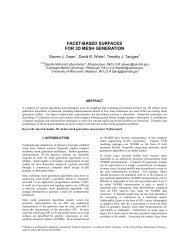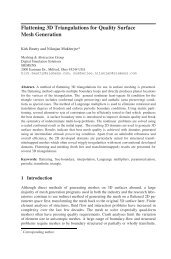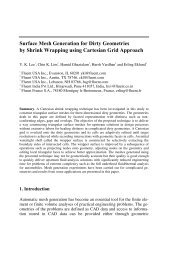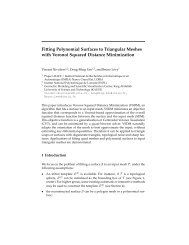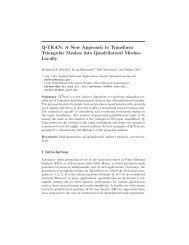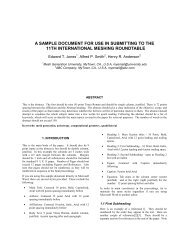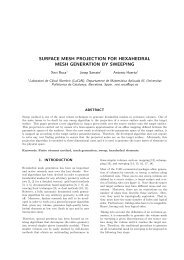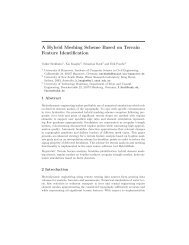Receding Front Method: a New Approach Applied to Generate ...
Receding Front Method: a New Approach Applied to Generate ...
Receding Front Method: a New Approach Applied to Generate ...
Create successful ePaper yourself
Turn your PDF publications into a flip-book with our unique Google optimized e-Paper software.
A-PDF Split DEMO : Purchase from www.A-PDF.com <strong>to</strong> remove the watermark<br />
<strong>Receding</strong> <strong>Front</strong> <strong>Method</strong>: a <strong>New</strong> <strong>Approach</strong> <strong>Applied</strong> <strong>to</strong><br />
<strong>Generate</strong> Hexahedral Meshes of Outer Domains<br />
Xevi Roca, Eloi Ruiz-Gironés, and Josep Sarrate<br />
Labora<strong>to</strong>ri de Càlcul Numèric (LaCàN),<br />
Departament de Matemàtica Aplicada III,<br />
Universitat Politècnica de Catalunya,<br />
Jordi Girona 1-3, E–08034 Barcelona, Spain<br />
{xevi.roca,eloi.ruiz,jose.sarrate}@upc.edu ⋆⋆<br />
Summary. Two of the most successful methods <strong>to</strong> generate unstructured hexahedral meshes<br />
are the grid-based methods and the advancing front methods. On the one hand, the grid-based<br />
methods generate high quality elements in the inner part of the domain using an inside-outside<br />
approach. On the other hand, advancing front methods generate high quality hexahedra near<br />
the boundary using an outside-inside approach. In this paper we propose the receding front<br />
method, an original approach that combines the advantages of both methodologies: we use<br />
an inside-outside mesh generation approach by means of a reversed front advance. We apply<br />
this approach <strong>to</strong> mesh outer domains. To reproduce the shape of the boundaries, we first precompute<br />
the mesh fronts by combining two solutions of the Eikonal equation on a tetrahedral<br />
reference mesh. Then, <strong>to</strong> generate high quality elements, we expand the quadrilateral surface<br />
mesh of the inner body <strong>to</strong>wards the unmeshed external boundary using the pre-computed<br />
fronts as a guide. Further research is under way in order <strong>to</strong> apply the proposed method <strong>to</strong> more<br />
complicated geometries.<br />
Key words: Mesh generation, unstructured hexahedra, eikonal equation<br />
1 Introduction<br />
During the last two decades several general-purpose algorithms for fully au<strong>to</strong>matic<br />
hexahedral mesh generation have been proposed, see [1, 2, 3, 4, 5, 6] for a survey.<br />
However, none of the existent algorithms is robust, au<strong>to</strong>matic and generates highquality<br />
meshes for any initial geometry. There are two families of methods that almost<br />
fulfill all these requirements, the grid-based and the advancing front methods.<br />
In fact, these approaches are the most successful methodologies <strong>to</strong> obtain a generalpurpose<br />
hex-meshing algorithm. Furthermore, the grid-based and advancing front<br />
⋆⋆ This work was partially sponsored by the Spanish Ministerio de Ciencia e Innovación under<br />
grants DPI2007-62395, BIA2007-66965 and CGL2008-06003-C03-02/CLI and by Universitat<br />
Politècnica de Catalunya (UPC)
2 X. Roca, E. Ruiz-Gironés and J. Sarrate<br />
methods have advantages and disadvantages that complement each other. Thus, we<br />
can consider how <strong>to</strong> obtain a hexahedral meshing approach that presents only the<br />
advantages, and avoids the disadvantages, of these two methods.<br />
On the one hand, the grid-based methods [7, 8, 9, 10] are the only family of<br />
robust and fully au<strong>to</strong>matic hexahedral mesh generation algorithms. In addition, they<br />
generate high-quality meshes in the inner part of the mesh. These advantages are<br />
possible because the mesh is generated from inside-<strong>to</strong>-outside. However, the gridbased<br />
methods generate low quality hexahedra near the boundary and the final mesh<br />
depends on the spatial orientation of the domain. These drawbacks appear because<br />
the inner mesh does not have layers of hexahedra that progressively adapt <strong>to</strong> the<br />
boundary shape of the domain.<br />
On the other hand, the advancing front methods [11, 12, 13] generate high-quality<br />
meshes near the boundary (boundary sensitive) that do not depend on the orientation<br />
of the object (orientation insensitive), see details on hex-meshing requirements in<br />
[2]. This is possible because the elements are generated layer by layer following the<br />
shape of the boundary surface. However, the advancing front methods are less robust<br />
and au<strong>to</strong>matic. When the fronts are advanced, from the boundary <strong>to</strong> the inner<br />
part, they collide and can delimit complex voids. Specifically, if the advancing front<br />
method starts with a prescribed quadrilateral mesh of the boundary (constrained approach)<br />
[11] the resulting void is, in general terms, over-constrained and cannot be<br />
meshed. On the contrary, the versions of the advancing front method that start without<br />
a prescribed mesh of the boundary (unconstrained approach) [12, 13] can always<br />
generate a hexahedral mesh for the void. To this end, usually the unconstrained methods<br />
[12, 13, 14, 15] use a tetrahedral mesh <strong>to</strong> generate a hexahedral one. However,<br />
the quality of the mesh of the inner void is not guaranteed because it results from<br />
splitting each tetrahedron in four hexahedra. These disadvantages at the inner part<br />
are caused because the elements are generated from outside-<strong>to</strong>-inside. Note that also<br />
there are constrained methods that directly transform a tetrahedral mesh in<strong>to</strong> a hexdominant<br />
mesh [16, 17].<br />
Summarizing, by generating elements from inside-<strong>to</strong>-outside we can avoid the<br />
front collisions that lead <strong>to</strong> unmeshed voids or low-quality inner meshes. Moreover,<br />
by generating the elements using fronts (layers of elements) we can obtain meshes<br />
that reproduce properly the shape of the domain boundary. In this work we apply<br />
these advantages <strong>to</strong> mesh outer domains. To this end, we propose:<br />
• To generate layers of elements from inside-<strong>to</strong>-outside. Hence, we present the first<br />
receding front method. That is, a reversed advancing front method.<br />
• To pre-compute the fronts (or layers of hexahedra) combining two solutions of<br />
the Eikonal equation. One solution determines the distance <strong>to</strong> the inner part and<br />
the other the distance <strong>to</strong> the outer boundary. The level sets of the combination of<br />
both solutions determine the fronts.<br />
This work is clearly related <strong>to</strong> the grid-based and advancing front methods. However,<br />
the grid-based methods do not generate layers of hexahedra from inside-<strong>to</strong>outside<br />
that smoothly adapt <strong>to</strong> the boundary of the domain. In addition, the advancing<br />
front methods do not start <strong>to</strong> generate layers of hexahedra from inside the domain. In
<strong>Receding</strong> <strong>Front</strong> <strong>Method</strong>: <strong>Applied</strong> <strong>to</strong> Outer Domains 3<br />
this sense, the proposed approach is different <strong>to</strong> both methodologies. Furthermore,<br />
we propose <strong>to</strong> pre-compute the fronts by solving the Eikonal equation. It is important<br />
<strong>to</strong> point out that there are other mesh generation works that use the Eikonal equation.<br />
In his seminar work, Sethian proposes a method <strong>to</strong> advance structured meshes by<br />
solving the Eikonal equation [18]. Another front propagation method based on the<br />
Eikonal equation is presented in [19]. In [20, 21], the authors show how <strong>to</strong> obtain<br />
the medial axis transform (MAT) by means of the Eikonal equation. Nevertheless,<br />
this is the first work were two solutions of the Eikonal equation are combined <strong>to</strong><br />
pre-compute the fronts and obtain an unstructured hexahedral mesh.<br />
The remainder of the paper is organized as follows. First, we present a 2D motivation<br />
example in Section 2. According <strong>to</strong> this motivation, in Section 3 we detail<br />
the receding front method. Specifically, we present how <strong>to</strong> pre-compute the fronts,<br />
generate the meshes between the fronts and refine the resulting hexahedral fronts.<br />
Finally, in Section 4 we present several example meshes that demonstrate the capabilities<br />
of the first implementation of the receding front method.<br />
2 2D Motivation<br />
To illustrate and clarify the basis of the receding front method in 3D, we consider a<br />
2D example. Specifically, we present a smooth domain with a three-branched skele<strong>to</strong>n<br />
<strong>to</strong> be meshed with quadrilateral (hexahedral) elements. With the help of this<br />
domain we first review the main advantages and disadvantages of the grid-based<br />
and advancing front methods. Then, we outline the proposed receding front method<br />
which combines the advantages of both methods.<br />
Given a domain, the grid-based methods first generate a quadrilateral (hexahedral)<br />
mesh in the inner part of the domain, Fig. 1(a). Then, the remaining void between<br />
the inner mesh and the boundary, Fig. 1(b), has <strong>to</strong> be meshed. To this end,<br />
several new nodes are created on the boundary. These nodes are connected with the<br />
quadrilateral elements of the boundary of the inner mesh <strong>to</strong> form the last layer of<br />
hexahedra, Fig. 1(c). Since the boundary of the inner mesh is not adapted <strong>to</strong> the<br />
shape of the domain boundary, the last layer of hexahedra can present low quality<br />
elements. We would like <strong>to</strong> remark that this approach is robust and can be applied <strong>to</strong><br />
general geometries <strong>to</strong> obtain meshes with high-quality elements in the inner part.<br />
The advancing front methods generate layers of elements (fronts) that start at the<br />
domain boundary and layer by layer reach (advance <strong>to</strong>wards) the inner part of the<br />
domain. At the last step, several elements that connect the fronts close the remaining<br />
void. There are two families of advancing front methods: the constrained [11] and<br />
the unconstrained approaches [12, 13].<br />
The constrained approach generates a first layer of elements, Fig. 2(a), that<br />
matches with a prescribed mesh of the boundary. Then, several layers of elements<br />
are generated by merging and matching the elements that are in front of the last<br />
layer, Fig. 2(b). Since the process starts with a prescribed mesh of the boundary<br />
and advance inwards, the last voids in the inner part of the domain can be complex
4 X. Roca, E. Ruiz-Gironés and J. Sarrate<br />
(a) (b) (c)<br />
Fig. 1. Several steps of a grid-based method: (a) inner mesh; (b) void between boundary and<br />
inner mesh; and (c) final mesh.<br />
(a) (b) (c)<br />
Fig. 2. Several steps of a constrained advancing front method: (a) first front; (b) last front and<br />
con<strong>to</strong>urs of the previous fronts; and (c) unmeshed void.<br />
(a) (b) (c)<br />
Fig. 3. Several steps of an unconstrained advancing front method: (a) fronts and final void; (b)<br />
simplicial mesh of the void; and (c) splitting simplicial mesh.<br />
and over-constrained. Specifically, in the 3D case the advance can lead <strong>to</strong> remaining<br />
voids that cannot be meshed, Fig. 2(c).<br />
The unconstrained approach relaxes the hex-meshing problem by considering<br />
that the domain boundary is not meshed. The meshing process starts at the boundary<br />
and provides a decomposition of the domain in several layers, Fig. 3(a). The process<br />
s<strong>to</strong>ps when the inner void can be discretized with a hex-meshing primitive. Since the<br />
inner void results from successive offsets of the boundary, it can be as much difficult<br />
<strong>to</strong> hex-mesh as the initial domain. Thus, there are configurations where the inner<br />
void can not be meshed with a high-quality hex-meshing primitive. However, it is<br />
always possible <strong>to</strong> generate a hexahedral mesh. To this end, this approach generates<br />
a simplicial mesh of the unrecognized inner void, Fig. 3(b). The simplicial mesh can<br />
always be split in quadrilateral (hexahedral) elements, Fig. 3(c). Then, the boundary<br />
of this inner mesh is propagated through the layers <strong>to</strong> the boundary of the domain.
<strong>Receding</strong> <strong>Front</strong> <strong>Method</strong>: <strong>Applied</strong> <strong>to</strong> Outer Domains 5<br />
(a) (b)<br />
(c) (d)<br />
Fig. 4. Pre-computing the fronts: (a) outer boundary and inner seed; (b) level sets from inside<br />
<strong>to</strong> outside; (c) level sets from outside <strong>to</strong> inside; and (d) combining inside-<strong>to</strong>-outside with<br />
outside-<strong>to</strong>-inside level sets.<br />
The quality of the inner elements is not guaranteed because they are originated by<br />
a simplicial mesh. Moreover, the boundary of the inner mesh is propagated through<br />
the domain <strong>to</strong> the boundary. Thus, the inner mesh determines the structure and the<br />
quality of the inner part of the boundary curves (surfaces). It is important <strong>to</strong> point out<br />
that the element quality close <strong>to</strong> the boundary features is ensured because it is a front<br />
approach, except when the boundary has a very sharp dihedral angle. In addition,<br />
this approach is fully au<strong>to</strong>matic and provides high-quality meshes for a wide range<br />
of geometries.<br />
To combine the advantages of both the grid-based and the advancing front methods,<br />
herein we propose the receding front method. To apply this methodology we<br />
require an initial mesh (seed) of the inner part of the domain, Fig. 4(a). Note that for<br />
the specific case of meshing the outer domain of a given body the initial mesh is a<br />
quadrilateral mesh of the body surface. This way, we can decouple the problem of<br />
generating the inner seed from the front generation process. The fronts that determine<br />
the layers of elements can be pre-computed. Specifically, we generate an offset of the<br />
shape of the inner seed <strong>to</strong>wards the boundary, Fig. 4(b), and an offset of the boundary<br />
shape inwards, Fig. 4(c). These offsets are obtained as the level sets of two solutions<br />
of the Eikonal equation, Section 3.1. One solution is related <strong>to</strong> the boundary of the<br />
inner part and the other one <strong>to</strong> the outer boundary. To compute these solutions we<br />
use an edge-based solver on a triangular (tetrahedral) mesh [22]. Then, we combine<br />
both solutions <strong>to</strong> obtain a function of the domain that reproduces the inner shape in<br />
the inner part and the boundary close <strong>to</strong> the outer part, Fig. 4(d). Then, the fronts are<br />
obtained as the level sets of this function. Finally, these fronts can be used as a guide<br />
<strong>to</strong> generate layers of elements starting from the inner seed and finishing in the outer<br />
boundary, Fig. 5. To this end, we need <strong>to</strong> consider a set of templates that determine<br />
how <strong>to</strong> offset the previous layer of elements <strong>to</strong> the new front, Section 3.2. Moreover,
6 X. Roca, E. Ruiz-Gironés and J. Sarrate<br />
(a) (b)<br />
(c) (d)<br />
Fig. 5. Layers of elements for the receding front method: (a) first layer; (b) second layer; (c)<br />
third layer; and (d) final layer.<br />
we have <strong>to</strong> consider a set of refinement rules that ensure that the element size is not<br />
surpassed. The resulting procedure generates layers of elements that progressively<br />
morph from the shape of the inner seed <strong>to</strong> the shape of the outer boundary. Moreover,<br />
starting from the inner part we can avoid over-constrained or complex inner<br />
voids.<br />
3 The <strong>Receding</strong> <strong>Front</strong> <strong>Method</strong><br />
The receding front method is decomposed in<strong>to</strong> two steps. First, we pre-compute a set<br />
of fronts between the inner and the outer boundaries. Second, we expand the quadrilateral<br />
mesh of the inner boundary <strong>to</strong>wards the unmeshed outer boundary according<br />
<strong>to</strong> the pre-computed fronts.<br />
3.1 Pre-computing the <strong>Front</strong>s<br />
Given a domain Ω ⊂ Rn , the Eikonal equation is the following non-linear partial<br />
differential equation <br />
∇d = f in Ω<br />
d| U⊂{Ω∪∂Ω} = 0,<br />
(1)<br />
where f is a known function and · is the euclidean norm. To solve the Eikonal<br />
equation, we first generate a tetrahedral mesh of the domain. Then, we obtain the<br />
solution for that discretization by means of an edge-based solver [22].<br />
For f = 1 the solution d is the distance from ∂Ω. For f = 1<br />
h(x) the level sets of<br />
the solution d follow the size field h(x) defined for each x ∈ ∂Ω. In this work we<br />
consider f = 1.
@ Win<br />
(a)<br />
@ Wout<br />
<strong>Receding</strong> <strong>Front</strong> <strong>Method</strong>: <strong>Applied</strong> <strong>to</strong> Outer Domains 7<br />
@ Win<br />
(b)<br />
@ Wout<br />
Fig. 6. Solution of the Eikonal equation starting from: (a) the outer boundary (∂Ωout) and, (b)<br />
the inner boundary (∂Ωin).<br />
In our applications we consider a domain bounded by an inner object (which<br />
defines the inner boundary of the domain, ∂Ωin) and a smooth outer boundary denoted<br />
by ∂Ωout. In order <strong>to</strong> find a distance field that takes in<strong>to</strong> account the distance<br />
from each inner point <strong>to</strong> both boundaries we first consider the following problem,<br />
see Figure 6(a): <br />
∇dout = 1 in Ω<br />
(2)<br />
dout|∂Ωout = 0,<br />
where dout 0. The solution of this problem provides the distance <strong>to</strong> the outer<br />
boundary. Then, we consider the problem, see Figure 6(b):<br />
<br />
∇din = 1 in Ω<br />
din|∂Ωin = 0,<br />
(3)<br />
where din 0. The solution of this problem provides the distance <strong>to</strong> the inner boundary.<br />
Note that we use the same tetrahedral mesh <strong>to</strong> solve Equations (2) and (3). The<br />
combined distance field, u, is defined as:<br />
u :=<br />
dout<br />
dout + din<br />
. (4)<br />
Note that the combined distance field verifies 0 u 1, and at the boundaries<br />
of the domain it also verifes that u|∂Ωout = 0 and u|∂Ωin = 1. Moreover, the con<strong>to</strong>urs<br />
of u close ∂Ωout are similar <strong>to</strong> dout whereas the con<strong>to</strong>urs of u close ∂Ωin are similar<br />
<strong>to</strong> din. That is, the combined distance field reproduces the shapes of the inner and<br />
outer boundaries close <strong>to</strong> them.<br />
Finally, we extract m level sets of the combined distance field u. These level<br />
sets determine the fronts used <strong>to</strong> advance the mesh from the meshed inner boundary<br />
<strong>to</strong>wards the meshed outer boundary. Algorithm 1 details the proposed procedure <strong>to</strong><br />
generate the level sets of the distance field.
8 X. Roca, E. Ruiz-Gironés and J. Sarrate<br />
Algorithm 1: <strong>Generate</strong> level sets ordered from inside <strong>to</strong> outside<br />
1<br />
2<br />
3<br />
4<br />
Input: ∂Ωin, inner boundary; ∂Ωout, outer boundary; m, number of level sets<br />
Output: L, level sets ordered from inside <strong>to</strong> outside<br />
Scalar field din ← solve Eikonal equation in Ω starting at ∂Ωin<br />
Scalar field dout ← solve Eikonal equation in Ω starting at ∂Ωout<br />
Scalar field u ← dout<br />
dout+d in<br />
Level sets L ← extract m iso-surfaces of u from 1 <strong>to</strong> 0<br />
Algorithm 2: <strong>Generate</strong> hexahedra between level sets<br />
1<br />
2<br />
3<br />
4<br />
5<br />
6<br />
7<br />
8<br />
Input: L, ordered level sets; Q0, quad surface mesh of the inner object<br />
Output: H, final hexahedral mesh<br />
Hex-mesh H ← {∅}<br />
foreach level set ℓ in L do<br />
Quad-mesh Qℓ ← get the quadrilateral mesh on ℓ<br />
detect geometric features of Qℓ<br />
Level set ℓnext ← get next level set <strong>to</strong> ℓ<br />
Hex-mesh Hℓ ← offset Qℓ from ℓ <strong>to</strong> ℓnext<br />
H ← H ∪ Hℓ<br />
refine H according <strong>to</strong> the prescribed element size<br />
3.2 Meshing the <strong>Front</strong>s<br />
From a quadrilateral surface mesh of the inner boundary we want <strong>to</strong> generate an<br />
unstructured hexahedral mesh of the domain without prescribing a quadrilateral surface<br />
mesh of the outer boundary. To this end, we detail in Algorithm 2 the proposed<br />
procedure. Each level-set will delimit a layer of hexahedral elements. Therefore, we<br />
have <strong>to</strong> describe the procedure <strong>to</strong> expand a quadrilateral mesh on level set ℓ <strong>to</strong> level<br />
set ℓ + 1. We first detect the geometric features of Qℓ and classify the edges of the<br />
quad mesh as corner, reversal and end according <strong>to</strong> the angles defined by the adjacent<br />
faces, φ. An edge is classified as corner if π/4 ≤ φ < 3π/4; as reversal if<br />
3π/4 ≤ φ < 5π/4; and as end if 5π/4 ≤ φ < 7π/4. Otherwise the edge is not<br />
a feature and it is classified as side. Once the edges are classified, we proceed <strong>to</strong><br />
classify the nodes of the quadrilateral mesh. A node is classified as feature node if<br />
it belongs <strong>to</strong> three o more feature edges. Otherwise, the node is classified as nonfeature<br />
node. Note that these two classifications will determine the <strong>to</strong>pology of the<br />
hexahedral mesh for the considered level.<br />
Once the edges and the nodes of the quadrilateral surface mesh are classified,<br />
we expand the quadrilateral mesh <strong>to</strong> the next level set. The expansion process is<br />
performed taking in<strong>to</strong> account the <strong>to</strong>pological entities of the quadrilateral mesh. First,<br />
we consider the faces of the quadrilateral mesh. Figure 7 illustrates the expansion of<br />
a quadrilateral face. Second, we expand the feature edges of the quadrilateral mesh
<strong>Receding</strong> <strong>Front</strong> <strong>Method</strong>: <strong>Applied</strong> <strong>to</strong> Outer Domains 9<br />
Fig. 7. Face template.<br />
corner reversal<br />
end<br />
Fig. 8. Edge templates.<br />
3C 2C - 1E 1C - 2E 3E<br />
3C - 3E 2C - 2E 2R - 1C 2R - 1E<br />
Fig. 9. Vertex templates.<br />
according <strong>to</strong> their classification. Figure 8 illustrates the templates used <strong>to</strong> expand<br />
feature edges of the quadrilateral mesh. Third, we expand the feature nodes of the<br />
quadrilateral mesh according <strong>to</strong> the classification of adjacent feature edges. Figure 9<br />
illustrates the templates used <strong>to</strong> expand feature nodes of the quadrilateral mesh.<br />
The size of the new hexahedra may differ from the prescribed element size. For<br />
this reason, a local refinement process is performed at each level. The edges of the<br />
new boundary that are longer than the prescribed element size are marked <strong>to</strong> be refined.<br />
Then, each hexahedron is replaced by a given template of hexahedra depending<br />
on the marked edges <strong>to</strong> be refined. To this end, we use the method proposed in [23]
10 X. Roca, E. Ruiz-Gironés and J. Sarrate<br />
where the templates introduced by [9, 10] are adapted <strong>to</strong> marked edges. At this point,<br />
the algorithm of front meshing is iterated until all the fronts are discretized.<br />
4 Examples<br />
In this section we present four meshes of the outer domain of a given object created<br />
with the receding front method. In all the cases the starting seed is a quadrilateral<br />
mesh of the inner surface. The user input is the element size of the quadrilateral<br />
mesh and the number of levels of the mesh.<br />
4.1 Long box<br />
The first example presents a mesh generated on the exterior domain of a long box.<br />
The box is located inside a smooth domain. Note that the inner boundary only contains<br />
feature edges classified as corner, see Section 3.1. Figure 10(a) presents the<br />
tetrahedral mesh used <strong>to</strong> compute the solution of both Eikonal equations. Figure<br />
10(b) presents the pre-computed fronts as detailed in Section 3.1. Note that we have<br />
prescribed four levels in order <strong>to</strong> generate the mesh. Figure 10(c) shows a general<br />
view of the hexahedral mesh while Figure 10(d) illustrates a longitudinal cut of the<br />
mesh. Although the quadrilateral surface mesh of the inner box is structured, the final<br />
mesh contains unstructured nodes both in the interior and on the boundary of the<br />
mesh. For instance, in Figure 10(c) we highlight a node with three adjacent hexahedra<br />
and in Figure 10(d) we mark an inner node with six adjacent hexahedra.<br />
4.2 Pentagonal star<br />
The second example presents the generated mesh for the domain delimited by a star<br />
placed inside a sphere. In this case the definition of the domain contains feature<br />
edges classified as corner and end. The final mesh is composed by eight levels of<br />
hexahedral elements. Figure 11(b) shows a cut of the mesh and Figure 11(c) presents<br />
a detail of the unstructured mesh. Note that the expansion of the seed surface mesh<br />
generates unstructured elements in order <strong>to</strong> reach properly the outer boundary.<br />
4.3 Smooth Object with a Reversal Feature<br />
The objective of the third example is <strong>to</strong> show that using a refinement procedure we<br />
can respect the prescribed element size in the final mesh. To this end, we discretize<br />
a domain delimited by a flat object inside an ellipsoid. This geometry only contains<br />
feature edges classified as reversal. First, we generate a hexahedral mesh without<br />
using the local refinement process described in Section 3.1. Figure 12 shows the final<br />
mesh. Note that the obtained element size near the outer boundary is greater than the<br />
obtained element size near the inner boundary. In order <strong>to</strong> preserve the prescribed<br />
element size, in each level we perform a local refinement. Figure 13 illustrates that<br />
the final mesh reproduces with more fidelity the prescribed element size. Note that<br />
in both cases an unstructured mesh is obtained.
<strong>Receding</strong> <strong>Front</strong> <strong>Method</strong>: <strong>Applied</strong> <strong>to</strong> Outer Domains 11<br />
(a) (b)<br />
(c) (d)<br />
Fig. 10. Hexahedral mesh for the exterior domain of the long box. (a) Tetrahedral mesh used<br />
<strong>to</strong> solve the Eikonal equation. (b) Level sets of the combined distance field. (c) General view<br />
of the hexahedral mesh. (d) Longitudinal cut of the hexahedral mesh.<br />
4.4 Space Capsule<br />
One of the advantages of the proposed approach is that it is straightforward <strong>to</strong> stretch<br />
the elements in the normal direction of the fronts. To this end, we use a blending<br />
function [24] that modifies the combined distance field u introduced in equation (4):<br />
u = eαu−1<br />
eα , (5)<br />
− 1<br />
where α ∈ R. If α < 0, the levels are concentrated <strong>to</strong>wards the outer boundary.<br />
If α > 0, the levels are concentrated <strong>to</strong>wards the inner boundary. To illustrate the<br />
behavior of the blending function (5), we present in Figure 14(a) a uniform level set<br />
distribution defined on a simple geometry. Figure 14(b) presents the new the level<br />
set distribution when equation (5) is applied with α = 5. Note that the level sets are<br />
concentrated <strong>to</strong>wards the inner boundary.
12 X. Roca, E. Ruiz-Gironés and J. Sarrate<br />
(a)<br />
(b) (c)<br />
Fig. 11. Hexahedral mesh for the exterior domain of the pentagonal star. (a) General view. (b)<br />
Vertical cut. (c) Detail of an unstructured region.<br />
Figure 15 presents the mesh generated on the exterior domain of a space capsule.<br />
In this mesh, we apply a boundary layer by using the blending function (5) with<br />
α = 7. The mesh is generated using 28 levels. Figure 15(b) shows a general view of<br />
the final mesh while Figure 15(b) shows a detail of the final mesh inner boundary.<br />
5 Concluding remarks and future work<br />
In this work we have proposed the receding front method, a new approach for generating<br />
unstructured hexahedral meshes applied <strong>to</strong> generate hexahedral meshes of outer<br />
domains. Specifically, the two main contributions of this work are <strong>to</strong> pre-compute
<strong>Receding</strong> <strong>Front</strong> <strong>Method</strong>: <strong>Applied</strong> <strong>to</strong> Outer Domains 13<br />
(a) (b)<br />
Fig. 12. Hexahedral mesh without local refinement for the exterior domain of the smooth<br />
object with a reversal feature. (a) General view of the outer boundary mesh. (b) Longitudinal<br />
cut.<br />
the meshing fronts by combining two solutions of the Eikonal equation, and <strong>to</strong> advance<br />
unstructured hexahedral elements from inside-<strong>to</strong>-outside (recede) guided by<br />
the pre-computed fronts. The former allows us <strong>to</strong> obtain meshes that reproduce the<br />
domain shape close <strong>to</strong> the outer boundary. The latter allows us <strong>to</strong> avoid the collision<br />
of constrained meshing fronts. We have implemented the proposed method in the<br />
ez4u meshing environment [25]. The first results show the possibilities of the receding<br />
front method applied <strong>to</strong> the unstructured hexahedral mesh generation of exterior<br />
domains. Moreover, we show that it is straightforward <strong>to</strong> obtain stretched meshes<br />
along the normal direction of the domain boundaries.<br />
Our long-term goal is <strong>to</strong> obtain a general-purpose unstructured hexahedral mesh<br />
genera<strong>to</strong>r based on the receding front method. In this sense, the first implementation<br />
of the method presents several issues that should be investigated and solved in the<br />
near future. First, we are currently including additional advancing and refinement<br />
templates. These templates allow us <strong>to</strong> improve the quality of the meshes obtained<br />
by advancing the elements from one layer <strong>to</strong> the following one. Second, we want <strong>to</strong><br />
extend the presented approach <strong>to</strong> mesh the exterior domain of several objects and<br />
objects with holes, for instance a <strong>to</strong>rus inside a sphere. Third, we want <strong>to</strong> apply the<br />
exterior domain meshing <strong>to</strong>ol <strong>to</strong> outer boundaries with feature curves and vertices.<br />
To this end, we need <strong>to</strong> develop an imprinting technique that allows <strong>to</strong> propagate<br />
through the fronts the features of the outer boundary <strong>to</strong>wards the inner boundary.<br />
These imprints would determine a decomposition of the domain in sub-volumes that<br />
connect the outer boundary with the inner boundary. Then, we can restrict the receding<br />
front method <strong>to</strong> each one of the sub-volumes <strong>to</strong> advance layer-by-layer unstructured<br />
hexahedra from the inner mesh <strong>to</strong> the outer boundary. The resulting hexmeshing<br />
primitive would respect the boundary features and would be equivalent <strong>to</strong><br />
a fully unstructured sweeping (regular sweeping is semi-structured). Fourth, we will
14 X. Roca, E. Ruiz-Gironés and J. Sarrate<br />
(a)<br />
(b) (c)<br />
Fig. 13. Hexahedral mesh with local refinement for the exterior domain of the smooth object<br />
with a reversal feature. (a) General view of the outer boundary mesh. (b) Longitudinal cut. (c)<br />
Detail of the inner levels.<br />
analyze how <strong>to</strong> deal with narrow regions where the thickness of the part is significantly<br />
smaller (for instance one order of magnitude) than the surrounding volume.<br />
Since our approach generates the same number of levels in the whole domain, the<br />
distance between two consecutive level sets is variable. Therefore, it could be interesting<br />
<strong>to</strong> generate different number of hexahedral layers in different regions bounded<br />
by two consecutive level sets. To this end, we will investigate how <strong>to</strong> discontinue a<br />
layer and connect it <strong>to</strong> the boundary in one part of the model, but continue advancing<br />
the fronts in other parts. Fifth, we have <strong>to</strong> investigate how <strong>to</strong> au<strong>to</strong>matically generate<br />
an inner hexahedral mesh that approximately reproduces the skele<strong>to</strong>n of the domain.<br />
To this end, we have considered <strong>to</strong> use a similar technique <strong>to</strong> the one proposed in<br />
[20, 21]. Then, we can obtain an au<strong>to</strong>matic unstructured hexahedral mesh genera<strong>to</strong>r<br />
by means of advancing the fronts from inside-<strong>to</strong>-outside with the receding front
<strong>Receding</strong> <strong>Front</strong> <strong>Method</strong>: <strong>Applied</strong> <strong>to</strong> Outer Domains 15<br />
(a) (b)<br />
Fig. 14. Distribution of the level sets: (a) uniform; and (b) concentrating <strong>to</strong>wards the inner<br />
boundary (α = 5).<br />
method. Finally, we have <strong>to</strong> analyze how the accuracy of the Eikonal equation solution<br />
influences in the resulting hexahedral mesh.<br />
References<br />
1. SJ Owen. A survey for unstructured mesh generation technology. In 7th International<br />
Meshing Roundtable, pages 239–267, 1998.<br />
2. TD Blacker. Au<strong>to</strong>mated conformal hexahedral meshing constraints, challenges and opportunities.<br />
Engineering with Computers, 17(3):201–210, 2001.<br />
3. TJ Tautges. The generation of hexahedral meshes for assembly geometry: survey and<br />
progress. International Journal for Numerical <strong>Method</strong>s in Engineering, 50(12):2617–<br />
2642, 2001.<br />
4. TJ Baker. Mesh generation: Art or science? Progress in Aerospace Sciences, 41(1):29–63,<br />
2005.<br />
5. FJ Shepherd. Topologic and geometric constraint-based hexahedral mesh generation.<br />
PhD thesis, The University of Utah, 2007.<br />
6. X Roca. Paving the path <strong>to</strong>wards au<strong>to</strong>matic hexahedral mesh generation. PhD thesis,<br />
Universitat Politècnica de Catalunya, 2009.<br />
7. R Schneiders and R Bünten. Au<strong>to</strong>matic generation of hexahedral finite element meshes.<br />
Computer Aided Geometric Design, 12(7):693–707, 1995.<br />
8. R Schneiders. A grid-based algorithm for the generation of hexahedral element meshes.<br />
Engineering with Computers, 12(3):168–177, 1996.<br />
9. Y Zhang, C Bajaj, and BS Sohn. 3D finite element meshing from imaging data. Computer<br />
<strong>Method</strong>s in <strong>Applied</strong> Mechanics and Engineering, 194(48-49):5083–5106, 2005.<br />
10. Y Zhang and C Bajaj. Adaptive and quality quadrilateral/hexahedral meshing from volumetric<br />
data. Computer <strong>Method</strong>s in <strong>Applied</strong> Mechanics and Engineering, 195(9-12):942–<br />
960, 2006.<br />
11. TD Blacker and RJ Meyers. Seams and wedges in Plastering: a 3-D hexahedral mesh<br />
generation algorithm. Engineering with computers, 9(2):83–93, 1993.<br />
12. ML Staten, SJ Owen, and TD Blacker. Unconstrained paving and plastering: A new idea<br />
for all hexahedral mesh generation. In 14th International Meshing Roundtable, 2005.
16 X. Roca, E. Ruiz-Gironés and J. Sarrate<br />
(a)<br />
(b) (c)<br />
Fig. 15. Hexahedral mesh for the exterior domain of the space capsule. (a) General view of<br />
the outer boundary mesh. (b) Longitudinal cut. (c) Detail of the inner levels.<br />
13. ML Staten, RA Kerr, SJ Owen, TD Blacker, M Stupazzini, and K Shimada. Unconstrained<br />
plastering-hexahedral mesh generation via advancing-front geometry decomposition. International<br />
Journal for Numerical <strong>Method</strong>s in Engineering, 81(2):135–171, 2009.<br />
14. N Kowalski, F Ledoux, ML Staten, and SJ Owen. Fun sheet matching - au<strong>to</strong>matic generation<br />
of block-structured hexahedral mesh using fundamental sheets. In 10th USNCCM,<br />
2009.<br />
15. X Roca and J Sarrate. Local dual contributions: Representing dual surfaces for block<br />
meshing. International Journal for Numerical <strong>Method</strong>s in Engineering, 83(6):709–740,<br />
2010.<br />
16. S Meshkat and D. Talmor. Generating a mixed mesh of hexahedra, pentahedra and tetrahedra<br />
from an underlying tetrahedral mesh. International Journal for Numerical <strong>Method</strong>s<br />
in Engineering, 49(1-2):17–30, 2000.
<strong>Receding</strong> <strong>Front</strong> <strong>Method</strong>: <strong>Applied</strong> <strong>to</strong> Outer Domains 17<br />
17. SJ Owen and S Saigal. H-Morph: an indirect approach <strong>to</strong> advancing front hex meshing.<br />
International Journal for Numerical <strong>Method</strong>s in Engineering, 49(1-2):289–312, 2000.<br />
18. JA Sethian. Curvature flow and entropy conditions applied <strong>to</strong> grid generation. J. Comp.<br />
Phys, 1994.<br />
19. Y Wang, F Guibault, and R Camarero. Eikonal equation-based front propagation for<br />
arbitrary complex configurations. International Journal for Numerical <strong>Method</strong>s in Engineering,<br />
73(2):226–247, 2007.<br />
20. H Xia and PG Tucker. Finite volume distance field and its application <strong>to</strong> medial axis<br />
transforms. International Journal for Numerical <strong>Method</strong>s in Engineering, 82(1):114–<br />
134, 2009.<br />
21. H Xia and PG Tucker. Distance solutions for medial axis transform. In Proceedings of<br />
the 18th International Meshing Roundtable, pages 247–265, 2009.<br />
22. JA Sethian. Level set methods and fast marching methods. Cambridge university press<br />
Cambridge, 1999.<br />
23. J Carreras. Refinament conforme per malles de quadrilàters i hexàedres. Master’s thesis,<br />
Facultat de Matemàtiques i Estadística. Universitat Politècnica de Catalunya, 2008.<br />
24. JF Thompson. Handbook of Grid Generation. CRC Press, 1999.<br />
25. X Roca, J Sarrate, and E Ruiz-Gironés. A graphical modeling and mesh generation environment<br />
for simulations based on boundary representation data. In Congresso de Mé<strong>to</strong>dos<br />
Numéricos em Engenharia, 2007.




